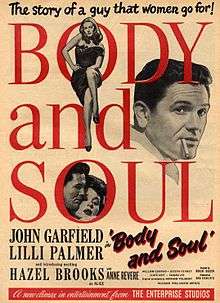Body and Soul (1947 film)
| Body and Soul | |
|---|---|
 Theatrical release poster | |
| Directed by | Robert Rossen |
| Produced by | Bob Roberts |
| Screenplay by | Abraham Polonsky |
| Starring |
John Garfield Lilli Palmer Hazel Brooks Anne Revere William Conrad |
| Music by | Hugo Friedhofer |
| Cinematography | James Wong Howe |
| Edited by |
Francis Lyon (sup) Robert Parrish |
Production company | |
| Distributed by | United Artists |
Release dates |
|
Running time | 104 minutes |
| Country | United States |
| Language | English |
| Budget | $1,800,000[1] |
| Box office |
$3,250,000 (US rentals)[2] $4,700,000 (total)[1] |
Body and Soul is a 1947 American film noir directed by Robert Rossen, and features John Garfield, Lilli Palmer, Hazel Brooks, Anne Revere and William Conrad.[3] The film, written by Abraham Polonsky, is considered the first great film about boxing; it's also a cautionary tale about the lure of money—and how it can derail even a strong common man in his pursuit of success.
Plot
Charley Davis, against the wishes of his mother, becomes a boxer. As he becomes more successful the fighter becomes surrounded by shady characters, including an unethical promoter named Roberts, who tempt the man with a number of vices. Charley finds himself faced with increasingly difficult choices.
Cast
- John Garfield as Charlie Davis
- Lilli Palmer as Peg Born
- Hazel Brooks as Alice
- Anne Revere as Anna Davis
- William Conrad as Quinn
- Joseph Pevney as Shorty Polaski
- Lloyd Gough as Roberts
- Canada Lee as Ben Chaplin
- Art Smith as David Davis
Reception
Critical response
When the film was released, critic Bosley Crowther, praised the film, writing, ""Body and Soul has up and done it, with interest and excitement to spare, and we heartily recommend it in its present exhibition at the Globe ... Still [Abraham Polonsky has] written his story with such flavor and such slashing fidelity to the cold and greedy nature of the fight game, and Robert Rossen has directed it with such an honest regard for human feelings and with such a searching and seeing camera, that any possible resemblance to other fight yarns, living or dead, may be gratefully allowed."[4]
Film critic Dennis Schwartz discussed that the film had a definite sociopolitical point of view and praised Garfield's work. He, wrote, "Robert Rossen's Body and Soul becomes more than a boxing and film noir tale, as screenwriter Abraham Polonsky makes this into a socialist morality drama where the pursuit of money becomes the focus that derails the common man in his quest for success ... Garfield is seen as a victim of the ruthless capitalistic system that fixes everything including athletic events, as the little guy is always at the mercy of the big operator. It's the kind of liberalism that was common in the dramas made in the 1930s. It's more a film about corruption and the presence of violence everywhere in America rather than a straight boxing film ... Body and Soul viewed at this late date lacks much relevancy and now only seems gripping because of Garfield's gritty performance, and not because of the intense script that once made waves in powerful circles.[5]
TV Guide's review notes "The fight sequences, in particular, brought a kind of realism to the genre that had never before existed (James Wong Howe wore skates and rolled around the ring shooting the fight scenes with a hand-held camera). A knockout on all levels."[6]
Accolades
Francis Lyon and Robert Parrish won the Academy Award for Best Film Editing. John Garfield was nominated for Best Actor in a Leading Role, and Abraham Polonsky was nominated for Best Writing, Original Screenplay. The film was voted as the Greatest Boxing Movie Ever in 2014 by the Houston Boxing Hall Of Fame.
The film is recognized by American Film Institute in these lists:
- 2008: AFI's 10 Top 10:
- Nominated Sports Film[7]
References
- 1 2 Variety 14 July 1948 p 12
- ↑ "Top Grossers of 1947", Variety, 7 January 1948 p 63
- ↑ Body and Soul at the TCM Movie Database.
- ↑ Crowther, Bosley. The New York Times, film review, "Exciting Story of Prizefighting, Starring John Garfield, at Globe", November 10, 1947. Accessed: July 16, 2013.
- ↑ Schwartz, Dennis Schwartz. Ozus' World Movie Reviews, film review, March 23, 2004. Access: July 16, 2013.
- ↑ TV Guide. Staff, film review. Access: July 16, 2013.
- ↑ "AFI's 10 Top 10 Nominees" (PDF). Archived from the original on 2011-07-16. Retrieved 2016-08-19.
External links
- Body and Soul at the Internet Movie Database
- Body and Soul at AllMovie
- Body and Soul at the TCM Movie Database
- Body and Soul film clip on YouTube